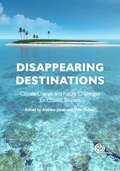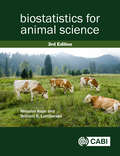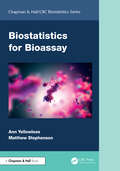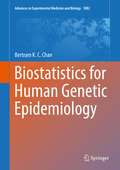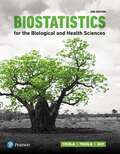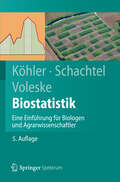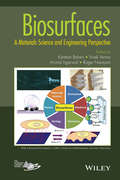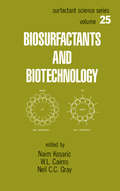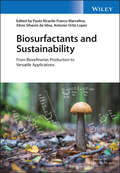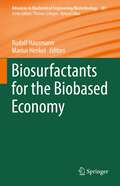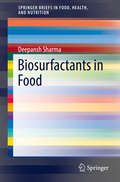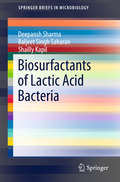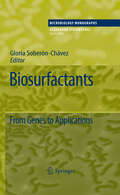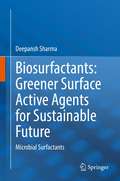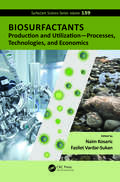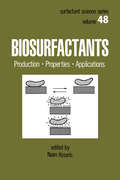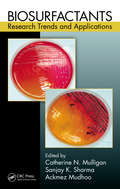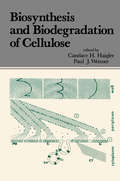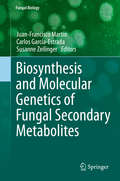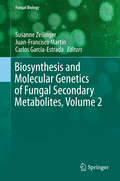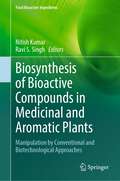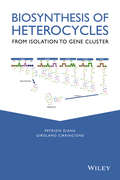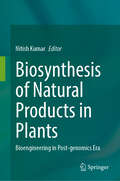- Table View
- List View
Biostatistics for Animal Science
by William Lamberson Miroslav KapsDesigned to cover techniques for analysis of data in the animal sciences, this textbook provides an overview of the basic principles of statistics enabling the subsequent applications to be carried out with familiarity and understanding, followed by more complex applications and detailed procedures commonly used in animal sciences. Each chapter begins by introducing a problem with practical questions, followed by a brief theoretical background, and is supplemented with an abundance of examples in SAS from animal sciences and related fields. Key features: New larger format and updated throughout Covers both basic techniques and more complex procedures Contains exercises for readers to work through
Biostatistics for Animal Science, 3rd Edition
by Miroslav Kaps William R. LambersonDesigned to cover techniques for analysis of data in the animal sciences, this popular textbook provides an overview of the basic principles of statistics enabling the subsequent applications to be carried out with familiarity and understanding. Each chapter begins by introducing a problem with practical questions, followed by a brief theoretical background. Most topics are followed up with numerical examples to illustrate the methods described using data-sets from animal sciences and related fields. The same examples are then solved using the SAS software package. Key features of this third edition: - Updated throughout, and covers a wealth of new distributions and new material on non-normal dependent variables - Improved clarity of text and examples - Includes both basic techniques and more complex procedures to provide an essential resource whatever your level - Contains exercises and many worked examples in SAS. Written primarily for students and researchers in animal sciences, the text is also useful for those studying agricultural, biological, and veterinary sciences.
Biostatistics for Bioassay (Chapman & Hall/CRC Biostatistics Series)
by Matthew Stephenson Ann YellowleesIn recent decades, there has been enormous growth in biologics research and development, with the accompanying development of biological assays for emerging products. In parallel, there have been substantial advances in statistical methodology, as well as technological advances in computer power, enabling new techniques to be implemented via statistical software. Biostatistics for Bioassay presents an overview of the statistical analysis techniques that are needed in order to report the results of biological assays. These assays are needed for testing all biological medicines, such as vaccines and cell therapies, to allow them to be released for use. Beginning with consideration of the performance characteristics required of a bioassay, including accuracy, precision, and combinations of these two attributes, the book builds a framework for statistical bioassay design.Features: Explains the statistical methods needed at each stage of the lifecycle of a bioassay Describes the demonstration of the bioassay’s performance, known as validation Covers the statistical techniques for monitoring the bioassay’s performance over time Details how to transfer the bioassay to another laboratory or replace critical reagents Provides examples at every stage, to allow the reader to work through the techniques and consolidate their understanding The book provides a resource for interested bioassay analysts, and statisticians working with bioassays. In bringing together best practices in statistics across the bioassay lifecycle into a single volume, it aims to provide a comprehensive and useful textbook for statistical analysis in bioassay.
Biostatistics for Human Genetic Epidemiology (Advances in Experimental Medicine and Biology #1082)
by Bertram K. ChanThe book illustrates how biostatistics may numerically summarize human genetic epidemiology using R, and may be used successfully to solve problems in quantitative Genetic Epidemiology Biostatistics for Human Genetic Epidemiology provides statistical methodologies and R recipes for human genetic epidemiologic problems. It begins by introducing all the necessary probabilistic and statistical foundations, before moving on to topics related human genetic epidemiology, with R codes illustrations for various examples. This clear and concise book covers human genetic epidemiology, using R in data analysis, including multivariate data analysis. It examines probabilistic and statistical theories for modeling human genetic epidemiology – leading the readers through an effective epidemiologic model, from simple to advanced levels. Classical mathematical, probabilistic, and statistical theory are thoroughly discussed and presented. This book also presents R as a calculator and using R in data analysis. Additionally, it covers Advanced Human Genetic Data Concepts, the Study of Human Genetic Variation, Manhattan Plots, as well as the Procedures for Multiple Comparison. Numerous Worked Examples are provided for illustrations of concepts and real-life applications. Biostatistics for Human Genetic Epidemiology is an ideal reference for professionals and students in Medicine (particularly in Preventive Medicine and Public Health Medical Practices), as well as in Genetics, Epidemiology, and Biostatistics.
Biostatistics for The Biological and Health Sciences
by Mario F. Triola Marc M. Triola Jason RoyReal-world applications connect statistical concepts to everyday life. This book uses a variety of real-world applications to bring statistical theories and methods to life. Through these examples and a friendly writing style, the 2nd Edition ensures that you understand concepts and develop skills in critical thinking, technology, and communication. The result of collaboration between a biological sciences expert and the author of the #1 statistics book in the country, Biostatistics for the Biological and Health Sciences provides an excellent introduction to statistics for readers interested in the biological, life, medical, and health sciences.
Biostatistics: A Foundation For Analysis In The Health Sciences
by Wayne W. Daniel Chad L. CrossThe ability to analyze and interpret enormous amounts of data has become a prerequisite for success in allied healthcare and the health sciences. Now in its 11th edition, Biostatistics: A Foundation for Analysis in the Health Sciences continues to offer in-depth guidance toward biostatistical concepts, techniques, and practical applications in the modern healthcare setting. Comprehensive in scope yet detailed in coverage, this text helps students understand—and appropriately use—probability distributions, sampling distributions, estimation, hypothesis testing, variance analysis, regression, correlation analysis, and other statistical tools fundamental to the science and practice of medicine.
Biostatistik: Eine Einführung für Biologen und Agrarwissenschaftler (Springer-Lehrbuch)
by Gabriel Schachtel Peter Voleske Wolfgang KöhlerDie Auswertung experimenteller Ergebnisse ist für Biologen und Agrarwissenschaftler ein wichtiges Handwerkszeug. Mit dieser gut verständlichen Einführung in Grundlagen und Anwendungen der Biometrie ist ein schneller Einstieg in die Statistik möglich. Soweit wie möglich wird ohne Formeln und mathematische Symbolik die hinter den Verfahren stehende Grundidee komplexer statistischer Verfahren erläutert. Die 5. Auflage enthält zusätzlich Schemata zur Versuchsplanung und Auswertung sowie ein erweitertes Glossar englischer Fachausdrücke.
Biostimulants: Exploring Sources and Applications (Plant Life and Environment Dynamics)
by Naleeni Ramawat Vijay BhardwajThis edited book is a comprehensive compilation highlighting sources of biostimulants, their production, influence on plant growth and development, and regulatory status of plant biostimulants for better understanding and opening new vistas for future research. Biostimulants, the biological formulations are known to meliorate the plants growth and vigour, improve nutritional efficiency along with maintaining their well-being mainly via providing protection against a wide range of infections. Both horticultural as well as agricultural crops involve the utilization of the biostimulants. Fulvic and humic acids, nitrogen-containing compounds, protein hydrolysates, favourable bacteria and fungi, and extracts of seaweed are the chief active components of these. The major driving force for these materials is the organic farming industry and demand for sustainable crop production. This book will be of great interest to researchers, teachers, climate change scientists, capacity builders, and policy makers. Moreover, this book does the work of a supplementary reading for students in various fields such as agriculture, soil science, ecology, environmental science and forestry at undergraduate as well as graduate level. This will be a gainful read for national and international agricultural scientists and the policy makers.• Elaborates on biostimulants induced influence of plant growth and development • Covers all aspects of biostimulants sources and its role in plant life in detail • Discusses evidence based approach in biostimulants sources and its useful applications in plants
Biosurfaces
by Roger Narayan Kantesh Balani Arvind Agarwal Vivek VermaIdeal as a graduate textbook, this title is aimed at helpingdesign effective biomaterials, taking into account the complexinteractions that occur at the interface when a synthetic materialis inserted into a living system. Surface reactivity,biochemistry, substrates, cleaning, preparation, and coatingsare presented, with numerous case studies and applicationsthroughout. Highlights include:Starts with concepts and works up to real-life applicationssuch as implantable devices, medical devices, prosthetics, and drugdelivery technologyAddresses surface reactivity, requirements for surface coating,cleaning and preparation techniques, and characterizationDiscusses the biological response to coatingsAddresses biomaterial-tissue interactionIncorporates nanomechanical properties and processingstrategies
Biosurfactants and Biotechnology (Surfactant Science Ser. #25)
by KosaricHere is the first comprehensive reference to examine microbial surface active agents (biosurfactants)and biological emulsifiers as applied in biotechnology and other industries.Biosurfactants and Biotechnology highlights state-of-the-art uses of these agents, and incorporatesa wealth of ideas for future research and development related to feedstocks, production,and processing. The book delineates the chemistry, biochemistry, mechanisms, and propertiesof biosurfactants and biological emulsifiers .. . critically assesses their role in enhanced oil recoveryand other industrial applications . .. and includes numerous references to the literature.Biosurfactants and Biotechnology is an invaluable guide for physical, surface, and colloidchemists working on or with surfactants, interfacial phenomena, and cell-surface physiology ;petrochemical, chemical, biochemical, petroleum, and pollution control engineers; pharmacologists,cosmetic scientists, food scientists, and microbiologists. It is also an important resourcefor graduate students in these fields.
Biosurfactants and Sustainability: From Biorefineries Production to Versatile Applications
by Paulo Ricardo Franco Marcelino Silvio Silverio da Silva Antonio Ortiz LopezBiosurfactants and Sustainability A timely and authoritative collection of resources on the sustainable production of biosurfactants In Biosurfactants and Sustainability, a team of distinguished researchers presents emerging themes in the rapidly evolving field of biosurfactants. The editors have chosen work that focuses on biosurfactants as eco-friendly and versatile compounds of interest in societies seeking sustainable forms of development. The book examines biosurfactants in the context of biorefineries and in the exploration of extremophilic microorganisms for biosurfactant production. The included works discuss biosurfactant production from different lignocellulosic and amylaceous raw materials, as well as oilseeds and other agro-industrial byproducts. Readers will also find: A thorough introduction to microorganisms producing biosurfactants, as well as sustainable biosurfactant production in biorefineries Comprehensive explorations of the challenges of biosurfactant production in fermentation processes Practical discussions of bioreactors and metabolic engineering used in biosurfactant production Fulsome treatments of biosurfactant production using enzyme and novel biosurfactant applications in nanotechnology, health, agriculture, and environmental cleanup Perfect for researchers and professionals with an interest in biosurfactant application and biotechnology processes, Biosurfactants and Sustainability will also benefit academic researchers, industry scientists, and engineers in biotechnology, microbiology, biomass conversion, environmental science and engineering.
Biosurfactants for the Biobased Economy (Advances in Biochemical Engineering/Biotechnology #181)
by Rudolf Hausmann Marius HenkelThis book provides a comprehensive overview of current biosurfactant research and applications. Public awareness of environmental issues has increased significantly over the last decade, a trend that has been accompanied by industry demands for climate-friendly and environmentally friendly renewable raw materials. In the context of household products, biosurfactants could potentially meet this demand in the future due to their low ecotoxicity, excellent biodegradability, and use of renewable raw materials. The diversity of this class of molecules, which has only been marginally tapped to date, offers only an inkling of their future application potential. However, there are two main obstacles to their widespread commercial use on the growing surfactant market: the lack of attractive and competitive production technologies, and the limited structural diversity of commercially available biosurfactants. Addressing both of these core issues, this book will provide readers with a deeper understanding of the role of biosurfactants, including future opportunities and challenges.
Biosurfactants in Food (SpringerBriefs in Food, Health, and Nutrition)
by Deepansh SharmaThe present work aims to cover the perspectives of biosurfactants, which can be of interest in food-related industries and biomedical applications. Biosurfactants are a structurally diverse group of surface-active molecules extensively produced by bacteria, yeast and fungi. Despite having significant potential associated with emulsion formation, anti-adhesive and antimicrobial activities, considerably few applications have been reported regarding applications of biosurfactants in food formulations and processing. The utilization of biosurfactants, which are highly functional in food and biomedical applications, has become more and more significant. Along with providing an overview of biosurfactant properties, the book suggests how these properties could be applicable in the food industry.
Biosurfactants of Lactic Acid Bacteria (SpringerBriefs in Microbiology #0)
by Deepansh Sharma Baljeet Singh Saharan Shailly KapilThis book provides an introduction to biosurfactants produced by lactic acid bacteria, presenting a detailed compilation of their functional properties and structural composition. Microbial surfactants, extensively known as surface-active agents, have created a niche for themselves in the green-chemicals market, thanks to their distinct environment-friendly properties. The demand for biosurfactants in the cosmetics, food, pharmaceuticals, agricultural and environmental industries is steadily growing, and biosurfactants from lactic acid bacteria possess significant biological properties, making them potentially suitable for antimicrobial, anti-adhesive and various other industrially important applications. Exploring these aspects in depth, the book offers a valuable resource for both postgraduate students and researchers in the fields of food and industrial microbiology.
Biosurfactants: From Genes to Applications (Microbiology Monographs #20)
by Gloria Soberón-ChávezBiosurfactants, tensio-active compounds produced by living cells, are now gaining increasing interest due to their potential applications in many different industrial areas in which to date almost exclusively synthetic surfactants have been used. Their unique structures and characteristics are just starting to be appreciated. In addition, biosurfactants are considered to be environmentally "friendly," relatively non-toxic and biodegradable. This Microbiology Monographs volume deals with the most recent advances in the field of microbial biosurfactants, such as rhamnolipids, serrawettins, trehalolipids, mannosylerythritol lipids, sophorolipids, surfactin and other lipopeptides. Each chapter reviews the characteristics of an individual biosurfactant including the physicochemical properties, the chemical structures, the role in the physiology of the producing microbes, the biosynthetic pathways, the genetic regulation, and the potential biotechnological applications.
Biosurfactants: Microbial Surfactants
by Deepansh SharmaThis book illustrates the importance and significance of the biosurfactants obtained from microorganisms, preferably from bacteria and yeast. It explains the superiority of biosurfactants (green molecule) over chemically synthesized surfactants for the sustainable future. The content of the present book addresses the quest for novel biosurfactants producing strains, high throughput screening methods, and production strategies. It finely describes the aptness of biosurfactants for industrial and environmental applications. It elaborately describes the technical background and cutting-edge advancement of the commercial aspect of biosurfactants. In the later part of the book, the role of green biosurfactants in food processing, control of food spoilage, incorporation in personal health care products, environmental and agricultural remediation are discussed. Finally, the book elucidates a comprehensive and representative description of toxicity assessment of the biosurfactants, which highlights the risk assessment of the incorporation of the microbial biosurfactants in food, healthcare, and pharmaceutical formulations.
Biosurfactants: Production and Utilization-Processes, Technologies, and Economics (Surfactant Science)
by Fazilet Vardar-Sukan Naim KosaricStresses the Potential Applications of Biosurfactants in Various IndustriesEnvironmental concerns and a demand for sustainable chemical production have become important issues in recent years. As a result, microbial biosurfactant-producing systems are gaining momentum as potential replacements for chemical surfactants. Biosurfactants: Production an
Biosurfactants: Production: Properties: Applications
by Naim KosaricProviding comprehensive discussions of the physical and chemical properties, manufacture, and industrial uses of biosurfactants, this reference offers first-hand accounts of biosurfactant research of leading biotechnology laboratories. It introduces promising possible uses of biosurfactants in medicine, in environmental control, and for marine
Biosurfactants: Research Trends and Applications
by Ackmez Mudhoo Sanjay K. Sharma Catherine N. MulliganMicrobially derived surfactants, called biosurfactants, provide a promising alternative to synthetic surfactants, displaying better availability and being generally nontoxic and biodegradable. Biosurfactants also have the advantage of diverse chemical properties and the potential to be less expensive. They demonstrate properties such as reducing su
Biosynthesis and Biodegradation of Cellulose
by Candace H. HaiglerA gathering of articles bringing together knowledge of both the synthesis and degradation of a pervasive biological substance, cellulose. Topics include native cellulose; particle rosettes and terminal globules; microfibril biogenesis; synthesis in Acetobacter xylinum ; biodegradation measurement; e
Biosynthesis and Molecular Genetics of Fungal Secondary Metabolites (Fungal Biology)
by Susanne Zeilinger Juan-Francisco Martín Carlos García-EstradaThis volume describes the more relevant secondary metabolites of different fungi with current information on their biosynthesis and molecular genetics. Bolstered with color illustrations and photographs, the book describes the possible application of molecular genetics to directed strain improvement in great detail. The needs for future developments in this field are also discussed at length Written by authorities in the field, Biosynthesis and Molecular Genetics of Fungal Secondary Metabolites provides a cutting-edge perspective on fungal secondary metabolism and underlying genetics and is a valuable resource for scientists, researchers, and educators in the field of fungal biology.
Biosynthesis and Molecular Genetics of Fungal Secondary Metabolites, Volume 2 (Fungal Biology)
by Susanne Zeilinger Juan-Francisco Martín Carlos García-EstradaFungi produce many chemically diverse secondary metabolites whose biological roles largely remain elusive. Within the increasing number of sequenced fungal genomes several important genes involved in secondary metabolite formation have been identified. Most of these genes are clustered and their coordinated transcription is controlled in a complex way by both narrow pathway-specific regulators as well as broad global transcription factors responsive to environmental cues. In recent years it was discovered many of the newly identified gene clusters are silent under laboratory conditions suggesting that the biosynthetic potential of fungi is far from being exploited. Besides identifying novel bioactive metabolites from still unexplored sources, the activation of these gene clusters by several approaches may result in the discovery of new substances with antibiotic and pharmaceutical benefits. This book covers recent advances in the field of fungal secondary metabolisms ranging from methodologies to biological aspects and will include the latest knowledge on fungal molecular biology, genomics, and metabolomics. With the related volume by Professor Juan-Francisco Martin, where the most relevant and well-studied fungal secondary metabolites are compiled, this book provides a comprehensive overview of the state-of-the-art of research on fungal secondary metabolites.
Biosynthesis of Bioactive Compounds in Medicinal and Aromatic Plants: Manipulation by Conventional and Biotechnological Approaches (Food Bioactive Ingredients)
by Nitish Kumar Ravi S. SinghPlant bioactive compounds are plant-based natural products that display a variety of pharmacological applications. These bioactive compounds are important as medicines, pigments and flavorings since most of the pharmaceutical industries are highly dependent on medicinal plants and their extraction. The types and concentrations of bioactive compounds produced by plants are determined by the species, genotype, physiology, developmental stage and environmental factors during growth, determining the physiological adaptive responses employed by various plant taxonomic groups in coping with the stress and defensive stimuli. In the past two decades there has been a renewed interest in the study of conventional aspects such as elicitors and biotic and abiotic stress factors that influence secondary metabolism during in vitro and in vivo growth of plants. the application of molecular biology tools and techniques are facilitating increased understanding of the signaling processes and pathways involved in the bioactive compounds production in subcellular, cellular, organ and whole plant systems during in vivo and in vitro growth, with application in the metabolic engineering of biosynthetic pathways intermediates. Biosynthesis and Manipulation of Bioactive compounds in Medicinal and Aromatic Plants provides a comprehensive introduction and review of the state-of-the-art biotechnological tools used in enhancement of bioactive compounds in medicinal and aromatic plants. Readers will find a systematic overview of techniques such as Omics, Crisper /Cas9 and RNAi to enhance plant bioactive contents including various in vitro techniques, hairy root culture and transgenic technology to enhance plant bioactive contents using plant tissue culture approaches. The chapters provide an overview of the role of induced mutation, biotic and abiotic stress to increase the bioactive contents in plants, plus the role of endophytes to enhance the contents of plant bioactive compounds and standard operating procedures using hydroponics system of cultivation for significant enhancement of bioactive compounds.This book serves as a single source for researchers working in plant secondary metabolites and the pharmaceutical industry.
Biosynthesis of Heterocycles
by Patrizia Diana Girolamo CirrincioneThis book describes biosynthetic methods to synthesize heterocyclic compounds, offering a guide for the development of new drugs based on natural products. The authors explain the role of natural products in chemistry and their formation along with important analytical methods and techniques for working with heterocycles.* Covers methods and techniques: isotopic labelling, enzymes and mutants, and pathway identification* Provides a thorough resource of information specifically on heterocyclic natural products and their practical biosynthetic relevance* Explains the role of natural products in chemistry and their formation* Discusses gene cluster identification and the use of biogenetic engineering in pharmaceutical application
Biosynthesis of Natural Products in Plants: Bioengineering in Post-genomics Era
by Nitish KumarThis book discusses the importance of plants in terms of their natural bioactive products and medicinal, nutraceutical and health benefits. Plants are natural sources of many pharmaceutical compounds used in traditional and modern medicine, and their mass production and efficient use is imperative in view of the new emerging diseases. This book covers breakthroughs in the research of plant natural products by focusing on how different state-of-the-art biotechnologies facilitate their discovery, the molecular basis of their biosynthesis, as well as synthetic biology. Research on plant's natural products in the pre-genomic era was focused on discovering bioactive molecules with pharmaceutical activities, and identifying individual genes responsible for biosynthesis. In the post-genomics era, however, integration of inter-disciplinary approaches and detailed analysis of all accessible data from multi-informatics is necessary. This would accelerate the full characterization of biosynthetic and regulatory circuit for producing plant natural products.This book is an important reference book for the researchers working in the field of plant natural products and pharmaceutical industries at global level.
